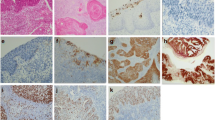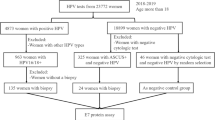Abstract
Cervical cancer is the fourth most common type of cancer in women worldwide. It is widely accepted that the main cause of cervical cancer, especially in underdeveloped countries like Pakistan, is the infection caused by the human papillomavirus (HPV). The current screening and diagnostic methods face several challenges in accurately detecting the various types of lesions caused by HPV. Therefore, the present study was conducted to assess the effectiveness of p16 immunohistochemistry (IHC) analysis as a diagnostic method in samples of cervical biopsies. One hundred cervical biopsy samples were obtained from female patients across various age groups (> 20– ≤ 30, > 31– ≤ 40, > 41– ≤ 50, > 51– ≤ 60 years). These samples were subsequently prepared for subsequent examination. All samples were analyzed using automated tissue processing followed by Hematoxylin and Eosin (H & E) staining, and p16 IHC tumour marker staining. The H & E slides showed changes in normal cervical tissues, while four cervical abnormalities were identified statistically significant using p16 marker including chronic cervicitis, nabothian cyst formation, cervical intraepithelial neoplasia, and cervical cancers (P value 0.014). Furthermore, among females of different age groups (> 31– ≤ 40, > 41– ≤ 50, > 51– ≤ 60 years) were found statistically significant suffering from cervical cancer (P value 0.04), HPV with cervical cancer (P value 0.01), HPV with cervical intraepithelial neoplasia (P value 0.01). Based on the available data, it can be inferred that the incorporation of the p16 tumor marker may be a valuable method for detecting high-risk HPV in cervical biopsies samples.


Similar content being viewed by others
References
Abdullah A, Qasim M, Shafiq M et al (2016) Molecular diagnosis and phylogenetic analysis of human papillomavirus type-16 from suspected patients in Pakistan. Infect Agents Cancer 11(1):1–7
Akhatova A, Azizan A, Atageldiyeva K et al (2022) Prophylactic Human Papillomavirus Vaccination: From the Origin to the Current State. Vaccines 10(11):1912
Alexander C, White M, Maleki Z, Rodriguez EF (2019) HPV-ISH-negative invasive cervical squamous cell carcinoma: histologic and pap test results. Acta Cytol 63(5):417–423
Asthana S, Busa V, Labani S (2020) Oral contraceptives use and risk of cervical cancer—A systematic review & meta-analysis. Europ J Obstetr Gynecol Reproduct Biol 247:163–175
Aziz H, Iqbal H, Mahmood H et al (2018) Human papillomavirus infection in females with normal cervical cytology: Genotyping and phylogenetic analysis among women in Punjab. Pakist Int J Infect Dis 66:83–89
Bray F, Ferlay J, Soerjomataram I, Siegel RL, Torre LA, Jemal A (2018) Global cancer statistics 2018: GLOBOCAN estimates of incidence and mortality worldwide for 36 cancers in 185 countries. CA Cancer J Clin 68:394–424
Bray F, Laversanne M, Weiderpass E, Arbyn M (2020) Geographic and temporal variations in the incidence of vulvar and vaginal cancers. Int J Cancer 147(10):2764–2771
Castle PE, Adcock R, Cuzick J et al (2020) Relationships of p16 immunohistochemistry and other biomarkers with diagnoses of cervical abnormalities: implications for LAST terminology. Arch Pathol Lab Med 144(6):725–734
Castro FA, Koshiol J, Quint W et al (2015) Detection of HPV DNA in paraffin-embedded cervical samples: a comparison of four genotyping methods. BMC Infect Dis 15(1):1–11
Chan CK, Aimagambetova G, Ukybassova T, Kongrtay K, Azizan A (2019) Human Papillomavirus Infection and Cervical Cancer: Epidemiology, Screening, and Vaccination-Review of Current Perspectives. J Oncol 2019:1–11
Colonna M, Grosclaude P, Bouvier AM, Goungounga J, Jooste V (2022) Health status of prevalent cancer cases as measured by mortality dynamics (cancer vs. noncancer): Application to five major cancers sites. Cancer 128(20):3663–3673
Dhakal R, Makaju R, Sharma S, Bhandari S, Shrestha S, Bastakoti R (2016) Correlation of cervical pap smear with biopsy in the lesion of cervix. Kathmandu Univ Med J 14(1):254–257
Ebrahim S, Mndende XK, Kharsany AB et al (2016) High burden of human papillomavirus (HPV) infection among young women in KwaZulu-Natal, South Africa. PLoS ONE 11(1):e0146603
Faridi R, Zahra A, Khan K, Idrees M (2011) Oncogenic potential of Human Papillomavirus (HPV) and its relation with cervical cancer. Virol J 8(1):1–8
Findik S, Findik S, Abuoğlu S, Cihan FG, Ilter H, Iyisoy MS (2019) Human papillomavirus (HPV) subtypes and their relationships with cervical smear results in cervical cancer screening: a community-based study from the central Anatolia region of Turkey. Int J Clin Exp Pathol 12(4):1391
Gameiro SF, Kolendowski B, Zhang A et al (2017) Human papillomavirus dysregulates the cellular apparatus controlling the methylation status of H3K27 in different human cancers to consistently alter gene expression regardless of tissue of origin. Oncotarget 8(42):72564
Gul S, Murad S, Javed A (2015) Prevalence of High risk Human Papillomavirus in cervical dysplasia and cancer samples from twin cities in Pakistan. Int J Infect Dis 34:14–19
Khan S, Noonari AA, Zehra F, Yousaf W, Ul Huda N, Qureshi A (2016) Prevalence of HPV in Pakistani women. Pathology 48:133
Krishnappa P, Mohamad IB, Lin YJ, Barua A (2014) Expression of P16 in high-risk human papillomavirus related lesions of the uterine cervix in a government hospital. Malaysia Diagn Pathol 9:1–6
Loya A, Serrano B, Rasheed F et al (2016) Human Papillomavirus genotype distribution in invasive cervical cancer in Pakistan. Cancers 8(8):72
Okunade KS (2020) Human papillomavirus and cervical cancer. J Obstet Gynaecol 40(5):602–608
Pimple S, Mishra G (2022) Cancer cervix: Epidemiology and disease burden. Cyto J 19:21
Qureishi A, Mawby T, Fraser L, Shah KA, Møller H, Winter S (2017) Current and future techniques for human papilloma virus (HPV) testing in oropharyngeal squamous cell carcinoma. Eur Arch Otorhinolaryngol 274:2675–2683
Raza S, Franceschi S, Pallardy S et al (2010) Human papillomavirus infection in women with and without cervical cancer in Karachi. Pak Br J Cancer 102(11):1657–1660
Reichheld A, Mukherjee PK, Rahman SM, David KV, Pricilla RA (2020) Prevalence of cervical cancer screening and awareness among women in an urban community in South India—a cross sectional study. Ann Glob Health 86:1
Riaz L, Manazir S, Jawed F, Ali SA, Riaz R (2020) Knowledge, perception, and prevention practices related to human papillomavirus-based cervical cancer and its socioeconomic correlates among women in Karachi Pakistan. Cureus 12:3
Sarwath H, Bansal D, Husain NE, Mohamed M, Sultan AA, Bedri S (2017) Introduction of p16INK4a as a surrogate biomarker for HPV in women with invasive cervical cancer in Sudan. Infect Agents Cancer 12(1):1–8
Siddiqa A, Zainab M, Qadri I, Bhatti MF, Parish JL (2014) Prevalence and genotyping of high risk human papillomavirus in cervical cancer samples from Punjab. Pakistan Viruses 6(7):2762–2777
Torre LA, Bray F, Siegel RL, Ferlay J, Lortet-Tieulent J, Jemal A (2015) Global cancer statistics, 2012. CA Cancer J Clin 65(2):87–108
Tsu VD, LaMontagne DS, Atuhebwe P, Bloem PN, Ndiaye C (2021) National implementation of HPV vaccination programs in low-resource countries: Lessons, challenges, and future prospects. Prev Med 144:106335
Xiang J, Han L, Fan Y et al (2021) Prevalence and genotype distribution of human papillomavirus among attendees at a sexually transmitted diseases clinic in urban Tianjin. China Int J Gen Med 14:1983
Yuan S, Qiu Y, Xu Y, Wang H (2020) Human papillomavirus infection and female infertility: a systematic review and meta-analysis. Reprod Biomed Online 40(2):229–237
Acknowledgements
We would like to thank the Institute of Microbiology, Government College University, Faisalabad for providing the entire basic logistics for this study. We also thank the Department of Pathology Ittifaq Hospital, Lahore and Aznostics Diagnostic Center Shadman, Lahore for facilitating sample collection.
Funding
This work is funded by the Researchers Supporting Project number (RSP2023R189), King Saud University, Riyadh, Saudi Arabia. The authors are grateful for this support.
Author information
Authors and Affiliations
Contributions
Conceptualization, writing the original draft, formal analysis, investigations: MS, IS, BA, RK, IT. Formal analysis, investigations, funding acquisition, resources, project administration, reviewing and editing. MHR, TAS, KS.A, MB, and MUQ. Reviewing and editing, data validation, and data curation.
Corresponding authors
Ethics declarations
Conflict of interest
The authors declare that there is no financial interest or other conflict of interest reported in this work among the authors.
Ethical approval
The ethical review committee of the Government College University, Faisalabad, Pakistan reviewed and approved this study. Importantly, informed consent was also obtained from patients included in the study and ethical guidelines were followed. The approval letter confirms that all necessary precautions were taken to ensure the protection of human subjects and adherence to ethical standards.
Additional information
Communicated by Ran Wang.
Publisher's Note
Springer Nature remains neutral with regard to jurisdictional claims in published maps and institutional affiliations.
Rights and permissions
Springer Nature or its licensor (e.g. a society or other partner) holds exclusive rights to this article under a publishing agreement with the author(s) or other rightsholder(s); author self-archiving of the accepted manuscript version of this article is solely governed by the terms of such publishing agreement and applicable law.
About this article
Cite this article
Shafique, M., Shoaib, I., Aslam, B. et al. Detection of high-risk human papillomavirus infected cervical biopsies samples by immunohistochemical expression of the p16 tumor marker. Arch Microbiol 206, 17 (2024). https://doi.org/10.1007/s00203-023-03736-0
Received:
Revised:
Accepted:
Published:
DOI: https://doi.org/10.1007/s00203-023-03736-0




